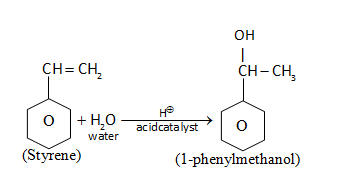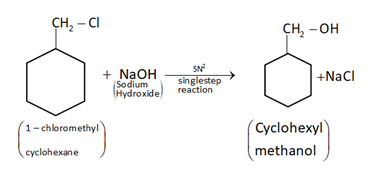Answer
36.9k+ views
Hint: These reactions are either electrophilic addition or nucleophilic substitution reaction. In an electrophilic addition reaction, a $\pi $ bond is broken and two new $\sigma $ bonds are formed. In nucleophilic substitution reaction, a leaving group is replaced by an electron rich compound.
Complete step by step solution:
Synthesis of the following reaction:
(i) 1-phenylethanol from suitable alkene.
Alkene is treated with \[{H_2}O\]in the presence of acid (acid catalyzed hydrolysis) to give 1-phenylmethanol

(ii) Cyclohexylmethanol using an alkyl halide by a \[S{N^2}\] reaction.
When chloromethylcyclohexane is treated with sodium hydroxide, then it will give cyclohexylmethanol by \[S{N^2}\]mechanism.

(iii) Pentan-1-ol using a suitable alkyl halide.
When chloropentane is treated with aq.$NaOH$, then it will give pentan-1-ol.
\[\mathop {C{H_3}C{H_2}C{H_2}C{H_2}C{H_2}}\limits_{\left( {1 - Chloropen\tan e} \right)} - Cl + \mathop {aq.NaOH}\limits_{\left( \begin{subarray}{l}
Sodium \\
Hydroxide
\end{subarray} \right)} \xrightarrow{{}}\mathop {C{H_3}C{H_2}C{H_2}C{H_2}C{H_2} - OH + NaCl}\limits_{\left( {Pen\tan - 1 - ol} \right)} \]
Note: Alpha methylbenzyl alcohol appears as a colourless liquid which is insoluble in water and less dense than water. Cyclohexylmethanol is an organic compound and these reactions are bimolecular nucleophilic substitution reactions. 1 - Pentanol is a colourless liquid with a distinctive aroma. It is the straight- chain form of amyl alcohol and the hydroxyl group is the active site of many reactions. Electrophilic addition reactions are an important class of reaction that allow the inter conversion of $C = C$and $C \equiv C$ into a range of important functional groups including alkyl halides and alcohols. Addition reaction is the reverse of elimination reactions and in nucleophilic substitution reactions, the stronger nucleophile replaces a weaker nucleophile.
Complete step by step solution:
Synthesis of the following reaction:
(i) 1-phenylethanol from suitable alkene.
Alkene is treated with \[{H_2}O\]in the presence of acid (acid catalyzed hydrolysis) to give 1-phenylmethanol

(ii) Cyclohexylmethanol using an alkyl halide by a \[S{N^2}\] reaction.
When chloromethylcyclohexane is treated with sodium hydroxide, then it will give cyclohexylmethanol by \[S{N^2}\]mechanism.

(iii) Pentan-1-ol using a suitable alkyl halide.
When chloropentane is treated with aq.$NaOH$, then it will give pentan-1-ol.
\[\mathop {C{H_3}C{H_2}C{H_2}C{H_2}C{H_2}}\limits_{\left( {1 - Chloropen\tan e} \right)} - Cl + \mathop {aq.NaOH}\limits_{\left( \begin{subarray}{l}
Sodium \\
Hydroxide
\end{subarray} \right)} \xrightarrow{{}}\mathop {C{H_3}C{H_2}C{H_2}C{H_2}C{H_2} - OH + NaCl}\limits_{\left( {Pen\tan - 1 - ol} \right)} \]
Note: Alpha methylbenzyl alcohol appears as a colourless liquid which is insoluble in water and less dense than water. Cyclohexylmethanol is an organic compound and these reactions are bimolecular nucleophilic substitution reactions. 1 - Pentanol is a colourless liquid with a distinctive aroma. It is the straight- chain form of amyl alcohol and the hydroxyl group is the active site of many reactions. Electrophilic addition reactions are an important class of reaction that allow the inter conversion of $C = C$and $C \equiv C$ into a range of important functional groups including alkyl halides and alcohols. Addition reaction is the reverse of elimination reactions and in nucleophilic substitution reactions, the stronger nucleophile replaces a weaker nucleophile.
Recently Updated Pages
To get a maximum current in an external resistance class 1 physics JEE_Main

If a wire of resistance R is stretched to double of class 12 physics JEE_Main

Let f be a twice differentiable such that fleft x rightfleft class 11 maths JEE_Main

Find the points of intersection of the tangents at class 11 maths JEE_Main

For the two circles x2+y216 and x2+y22y0 there isare class 11 maths JEE_Main

The path difference between two waves for constructive class 11 physics JEE_MAIN

Other Pages
The escape velocity from the earth is about 11 km second class 11 physics JEE_Main

The nitride ion in lithium nitride is composed of A class 11 chemistry JEE_Main

The ratio of speed of sound in Hydrogen to that in class 11 physics JEE_MAIN

Lowering in vapour pressure is highest for A 02 m urea class 11 chemistry JEE_Main

If a wire of resistance R is stretched to double of class 12 physics JEE_Main

Which of the following is a nonreducing sugar A Glucose class 12 chemistry JEE_Main



